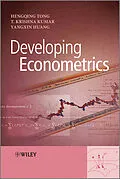Statistical Theories and Methods with Applications to Economics
and Business highlights recent advances in statistical theory
and methods that benefit econometric practice. It deals with
exploratory data analysis, a prerequisite to statistical modelling
and part of data mining. It provides recently developed
computational tools useful for data mining, analysing the reasons
to do data mining and the best techniques to use in a given
situation.
* Provides a detailed description of computer algorithms.
* Provides recently developed computational tools useful for data
mining
* Highlights recent advances in statistical theory and methods
that benefit econometric practice.
* Features examples with real life data.
* Accompanying software featuring DASC (Data Analysis and
Statistical Computing).
Essential reading for practitioners in any area of econometrics;
business analysts involved in economics and management; and
Graduate students and researchers in economics and statistics.
Autorentext
Hengqing Tong, Department of Mathematics, Wuhan University
of Technology, P.R.China
T. Krishna Kumar, Indian Institute of Management, Samkhya
Analytica India Private Limited, Bangalore, India
Yangxin Huang, Department of Epidemiology and
Biostatistics, University of South Florida, USA
Zusammenfassung
Statistical Theories and Methods with Applications to Economics and Business highlights recent advances in statistical theory and methods that benefit econometric practice. It deals with exploratory data analysis, a prerequisite to statistical modelling and part of data mining. It provides recently developed computational tools useful for data mining, analysing the reasons to do data mining and the best techniques to use in a given situation.
- Provides a detailed description of computer algorithms.
- Provides recently developed computational tools useful for data mining
- Highlights recent advances in statistical theory and methods that benefit econometric practice.
- Features examples with real life data.
- Accompanying software featuring DASC (Data Analysis and Statistical Computing).
Essential reading for practitioners in any area of econometrics; business analysts involved in economics and management; and Graduate students and researchers in economics and statistics.
Inhalt
Foreword xi
Preface xiii
Acknowledgements xvii
1 Introduction 1
1.1 Nature and Scope of Econometrics 2
1.1.1 What is Econometrics and Why Study Econometrics? 2
1.1.2 Econometrics and Scientific Credibility of Business and Economic Decisions 4
1.2 Types of Economic Problems, Types of Data, and Types of Models 5
1.2.1 Experimental Data from a Marketing Experiment 5
1.2.2 Cross-Section Data: National Sample Survey Data on Consumer Expenditure 6
1.2.3 Non-Experimental Data Taken from Secondary Sources: The Case of Pharmaceutical Industry in India 8
1.2.4 Loan Default Risk of a Customer and the Problem Facing Decision on a Loan Application 9
1.2.5 Panel Data: Performance of Banks in India by the Type of Ownership after Economic Reforms 10
1.2.6 Single Time Series Data: The Bombay Stock Exchange (BSE) Index 12
1.2.7 Multiple Time Series Data: Stock Prices in BRIC Countries 12
1.3 Pattern Recognition and Exploratory Data Analysis 14
1.3.1 Some Basic Issues in Econometric Modeling 14
1.3.2 Exploratory Data Analysis Using Correlations and Scatter Diagrams: The Relative Importance of Managerial Function and Labor 16
1.3.3 Cleaning and Reprocessing Data to Discover Patterns: BSE Index Data 22
1.4 Econometric Modeling: The Roadmap of This Book 24
1.4.1 The Econometric Modeling Strategy 24
1.4.2 Plan of the Book 25
Electronic References for Chapter 1 27
References 27
2 Independent Variables in Linear Regression Models 29
2.1 Brief Review of Linear Regression 29
2.1.1 Brief Review of Univariate Linear Regression 29
2.1.2 Brief Review of Multivariate Linear Regression 38
2.2 Selection of Independent Variable and Stepwise Regression 49
2.2.1 Principles of Selection of Independent Variables 49
2.2.2 Stepwise Regression 52
2.3 Multivariate Data Transformation and Polynomial Regression 57
2.3.1 Linear Regression after Multivariate Data Transformation 57
2.3.2 Polynomial Regression on an Independent Variable 61
2.3.3 Multivariable Polynomial Regression 62
2.4 Column Multicollinearity in Design Matrix and Ridge Regression 65
2.4.1 Effect of Column Multicollinearity of Design Matrix 65
2.4.2 Ridge Regression 68
2.4.3 Ridge Trace Analysis and Ridge Parameter Selection 70
2.4.4 Generalized Ridge Regression 71
2.5 Recombination of Independent Variable and Principal Components Regression 72
2.5.1 Concept of Principal Components Regression 72
2.5.2 Determination of Principal Component 74
Electronic References for Chapter 2 79
References 80
3 Alternative Structures of Residual Error in Linear Regression Models 83
3.1 Heteroscedasticity: Consequences and Tests for Its Existence 85
3.1.1 Consequences of Heteroscedasticity 85
3.1.2 Tests for Heteroscedasticity 87
3.2 Generalized Linear Model with Covariance Being a Diagonal Matrix 90
3.2.1 Diagonal Covariance Matrix and Weighted Least Squares 90
3.2.2 Model with Two Unknown Variances 91
3.2.3 Multiplicative Heteroscedastic Model 92
3.3 Autocorrelation in a Linear Model 95
3.3.1 Linear Model with First-Order Residual Autoregression 96
3.3.2 Autoregressive Conditional Heteroscedasticity (ARCH) Model 101
3.4 Generalized Linear Model with Positive Definite Covariance Matrix 106
3.4.1 Model Definition, Parameter Estimation and Hypothesis Tests 106
3.4.2 Some Equivalent Conditions 108
3.5 Random Effects and Variance Component Model 109
3.5.1 Random Effect Regression Model 109
3.5.2 The Variance Component Model 112
3.5.3 Analysis of Variance Method to Solve Variance Component Model 113
3.5.4 Minimum Norm Quadratic Unbiased Estimation (MINQUE) to Solve Variance Component 121
3.5.5 Maximum Likelihood Method to Solve Variance Component Model 124
Electronic References for Chapter 3...
